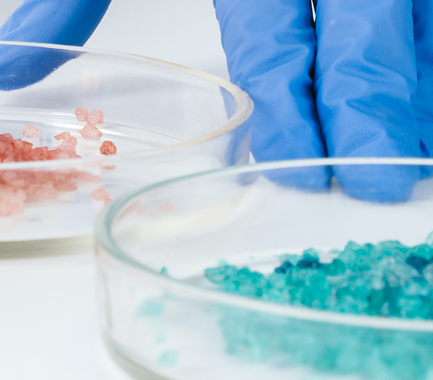Your contact
PENPET-Team - Hamburg

Christoph Meister
Sales
Tel. +49 (0) 40 - 675 7 99 30
sales@penpet.de
Get in touch with us.
Chlorinated paraffin
Mixtures of organic compounds consisting of saturated and unbranched hydrocarbons whose hydrogen atoms have been partially substituted by chlorination are referred to as chlorinated paraffin. The substances represent an important intermediate product in the chemical industry and are used in various industrial applications. They are produced at temperatures between 80 and 100 °C by reacting paraffins with chlorine gas. In some processes, the chlorination is also promoted by UV light or the addition of oxygen.
Mixtures of chlorinated paraffin are used as plasticizers in the production of coatings and plastics, as binders in paint production, as fatliquors in textile processing and as an additive to joint sealants. Due to their high chlorine content, the compounds are also suitable as flame retardants, since the hydrogen chloride formed at high temperatures inhibits the spread of fire. For this purpose, chlorinated paraffins are added to many products made of rubber, plastics, textiles and paper.
At PENPET you get chlorinated paraffin with a degree of chlorination of 45%, 52% or 70% - from a reliable partner who will also meet your requirements in the long term. We look forward to receiving your inquiry for an individual offer. Prompt delivery of the products can be made in packages with different weights.
CAS no. 63449-39-8
EINECS no. 264-150-0
Synonyms: Chlorinated Paraffins, Chlorinated Paraffins, Chlorinated Paraffin, Chlorinated Paraffin Waxes, Chlorinated Hydrocarbon Waxes, Chloroalkanes, Long-chain Chlorinated Paraffins, LCCP
Areas of application: Plasticizers for coatings and plastics, fatliquors for leather and textile processing, paint binders, additives for joint sealants, flame retardants
More Information
As a mixture of substances, chlorinated paraffin consists of different but structurally similar compounds. These are unbranched, aliphatic hydrocarbons whose hydrogen atoms have been partially replaced by chlorine atoms during the manufacturing process. A distinction is usually made between short-chain, medium-chain and long-chain chlorinated paraffin. The products we trade are long-chain chlorinated paraffins that are made up of eighteen or more carbon atoms and have a degree of chlorination of 45%, 52% or 70%. The properties of the substances differ depending on the proportion of the mass that the chlorine atoms make up.
Chlorinated paraffin is in liquid or solid form, depending on its degree of chlorination and the length of the hydrocarbon compounds it contains. The 45% and 52% by weight chlorine specifications we trade are supplied as a liquid, while the 70% by weight chlorinated paraffin has a waxy consistency at room temperature. The substances are hardly volatile and have a colorless to yellowish appearance. Liquid chlorinated paraffins change into a viscous melt and then into a solid form in the temperature range from -30 °C to -10 °C. Solid chlorinated paraffin becomes liquid at temperatures of approx. 100 °C.
The inherent odor of the compounds, reminiscent of chlorine, gradually increases as the degree of chlorination increases. As electrically very non-polar compounds, the substances are hardly soluble in water. On the other hand, chlorinated paraffin is readily soluble in organic solvents such as benzene, chloroform, acetone, diethyl ether, carbon tetrachloride, methanol and ethanol.
Chlorinated paraffin is chemically stable and hardly reactive. The products can be kept for a very long time if stored dry, airtight and cool. At higher temperatures, however, the compounds in the mixture of substances can react with bases and strong oxidizing agents. Chlorinated paraffin is difficult to ignite and is fire retardant due to the formation of hydrogen chloride in the event of a fire. If the substances are heated to the point of thermal decomposition, considerable amounts of irritating and harmful gases can be produced. Among other things, carbon dioxide, carbon monoxide, hydrogen chloride and chlorine gas are released.
According to the current state of medical knowledge, long-chain chlorinated paraffins pose only minor health risks. No toxic effects are known if the compounds are absorbed into the metabolism. However, a carcinogenic effect of the substances cannot currently be ruled out.
Chlorinated paraffin can cause slight redness and irritation on the skin. Residues should be removed from wetted areas of the body with soap and water. If symptoms persists, dermatological treatment should be carried out. If the liquid or solid chlorinated paraffin comes into contact with the eyes, only slight irritation of the mucous membrane is to be expected. The affected eye should be carefully rinsed with physiological saline solution. In the case of persistent impairments, an ophthalmological examination should be carried out. Inhalation of chlorinated paraffin vapors and aerosols may cause mild respiratory irritation. After a strong exposure, temporary breathing difficulties may also occur. Ingestion of the compounds can lead to gastrointestinal distress such as diarrhea.
Long-chain chlorinated paraffin is not considered a hazardous substance according to the GHS classification. With regard to possible damage to aquatic organisms, however, the compounds have been rated as slightly hazardous to water. It should not be released into the environment. Any leakage of liquid or solid chlorinated paraffin into bodies of water, soil or waste water must be reported to the responsible authorities. Chlorinated paraffin is not subject to special transport regulations.
